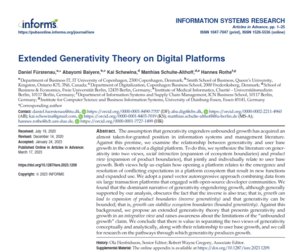News
Tue, 21. Mar. 2023 Rothe, Hannes
Extended Generativity Theory on Digital Platforms
New publication in Information Systems Research
We always thought that digital platforms are ever-changing, ever-growing. We simply ask what is growing: the userbase, the product, or the ecosystem? What we found was that this lets us question the ‘ever’.
In our recent article, published in Information Systems Research, we suggest an Extended Generativity Theory on Digital Platforms. This theory cautions a long-held assumption that generativity in platforms leads to unbounded growth. Following six large transaction platforms over 8 years, we study how platforms become generative through expansion of product and ecosystem boundaries in order to gain user growth. We were surprised to see that that these boundaries ebb and flow towards a dynamic equilibrium.
I am very happy to see this article finally being published. We started engaging with some of the material back in 2013, when I heard Peter Wolter presenting the eye opening changes at OTTO - a former catalog business becoming one of Europe's largest transaction platforms. A couple of years in and several conversations with the fantastic team - Daniel, Abayomi, Matthias, and Kai - we are happy to open up the conversation around generativity and platforms to the broader IS and management community.
Special thanks to Ola Henfridsson and Robert Wayne Gregory and the anonymous reviewers for their continuous support and thought-provoking input throughout the process!
Abstract:
The assumption that generativity engenders unbounded growth has acquired an almost taken-for-granted position in information systems and management literature. Against this premise, we examine the relationship between generativity and user base growth in the context of a digital platform. To do this, we synthesize the literature on gener-ativity into two views, social interaction (expansion of ecosystem boundaries) and product view (expansion of product boundaries), that jointly and individually relate to user base growth. Both views help us explain how opening a platform relates to the emergence and resolution of conflicting expectations in a platform ecosystem that result in new functions and expanded use. We adopt a panel vector autoregressive approach combining data from six large transaction platforms that engaged with open-source developer communities. We found that the dominant narrative of generativity engendering growth, although generally supported by our analysis, obscures the fact that the inverse is also true; that is, growth can lead to expansion of product boundaries (inverse generativity) and that generativity can be bounded; that is, growth can stabilize ecosystem boundaries (bounded generativity). Against this background, we propose an extended generativity theory that presents generativity and growth in an integrative view and raises awareness about the limitations of the “unbounded growth” claim. We conclude that there is value in separating the two views of generativity conceptually and analytically, along with their relationship to user base growth, and we call for research on the pathways through which generativity produces growth.
Link to article: https://pubsonline.informs.org/doi/epdf/10.1287/isre.2023.1209


